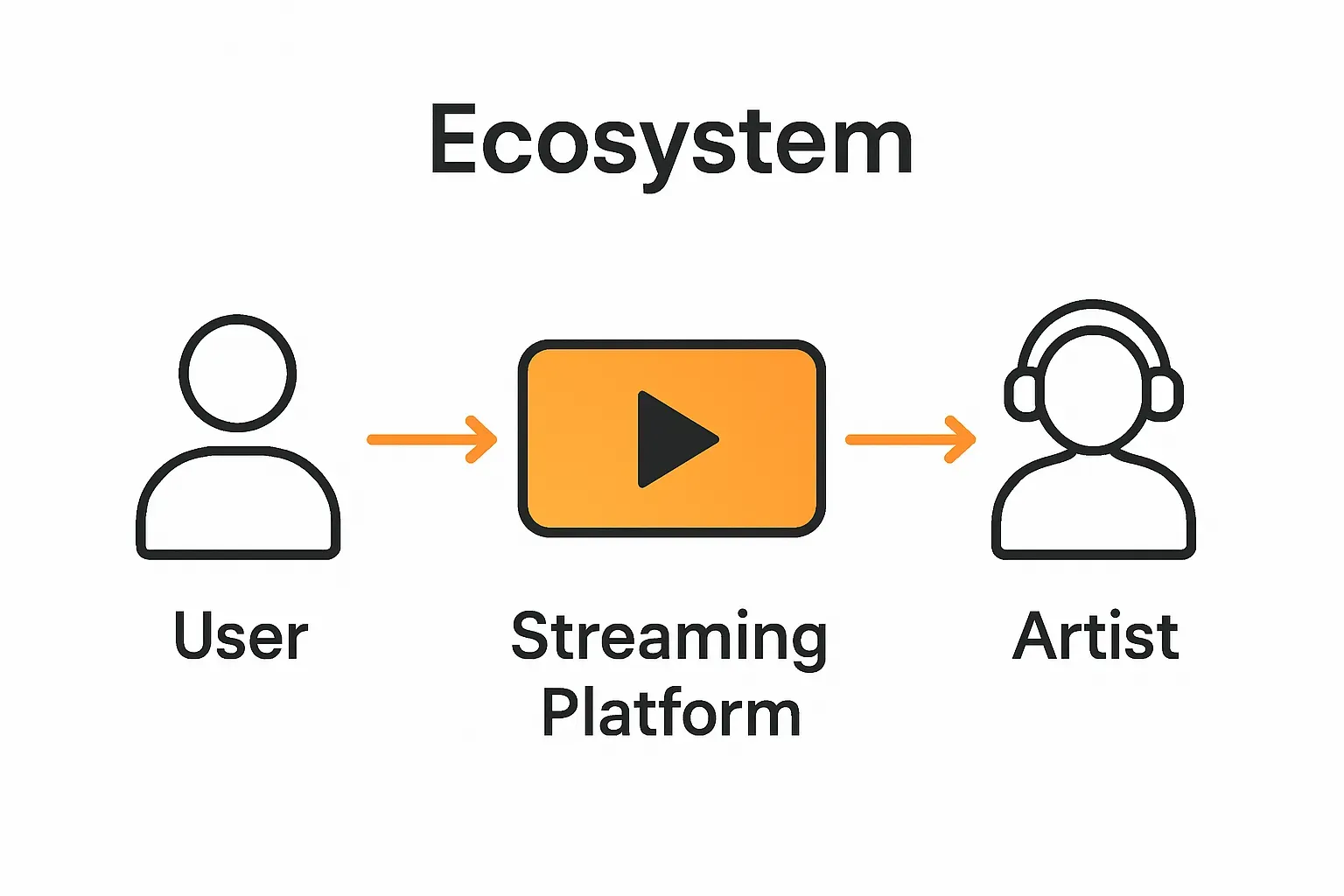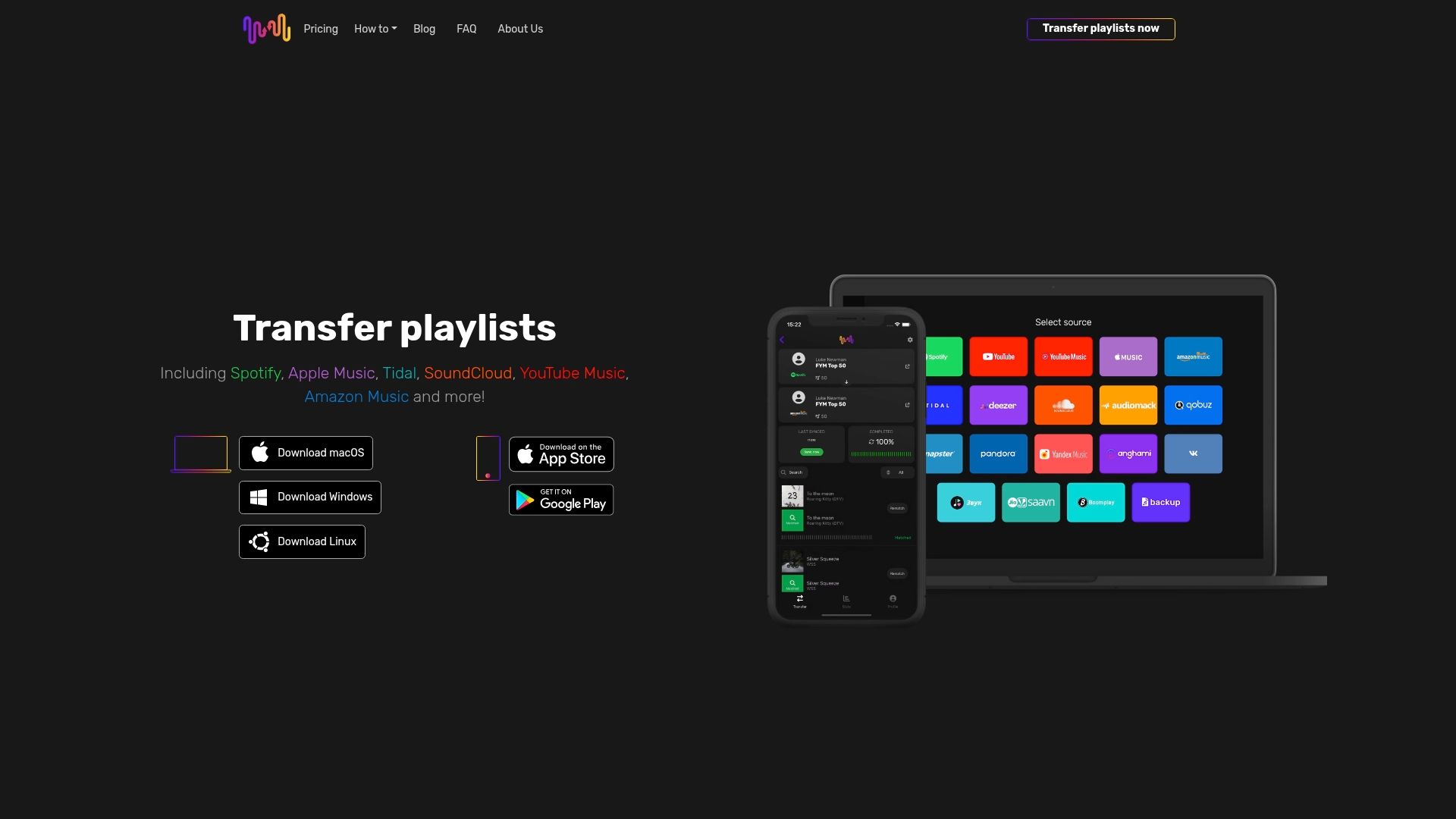Millions now listen to music through streaming apps, where playlists seem to know you better than your best friend. You might think it is just clever song suggestions and endless tracks on loop. But the world of music streaming is far more complex, built on ecosystems where algorithms can analyze your listening patterns with astonishing precision and even influence what becomes the next big hit. This changes not only how we hear songs but how music itself is shared, discovered, and even created.
Table of Contents
- What Are Music Streaming Ecosystems?
- The Importance of Music Streaming Ecosystems
- How Music Streaming Ecosystems Operate
- Key Components of Music Streaming Ecosystems
- The Future of Music Streaming Ecosystems
Quick Summary
| Takeaway | Explanation |
|---|---|
| Music streaming ecosystems are complex networks | These systems integrate multiple technological platforms for music consumption, distribution, and interaction. |
| Personalization shapes user experience | Advanced algorithms analyze preferences to curate tailored musical journeys for users. |
| Revenue models are evolving for artists | Streaming platforms have replaced traditional revenue streams with dynamic compensation based on listener engagement. |
| Cultural exchange is enhanced through platforms | Music streaming fosters global connectivity, introducing users to diverse genres and artists across borders. |
| Future innovations will redefine musical engagement | Emerging technologies promise immersive experiences, making music consumption more interactive and personalized. |
What Are Music Streaming Ecosystems?
Music streaming ecosystems represent complex digital networks where music consumption, distribution, and interaction converge through interconnected technological platforms. These digital environments transcend simple audio playback, creating intricate systems where users, artists, algorithms, and technology interact seamlessly.
The Fundamental Architecture
At its core, a music streaming ecosystem consists of multiple integrated components that work together to deliver personalized musical experiences. These components include streaming platforms, content delivery networks, recommendation algorithms, user interfaces, and backend infrastructure. Understanding music platform dynamics reveals how each element plays a critical role in creating a comprehensive musical experience.
Key architectural elements include:
- User interaction layers
- Content management systems
- Data processing and recommendation engines
- Payment and licensing infrastructure
- Cross platform connectivity mechanisms
Technology and User Experience Dynamics
Modern music streaming ecosystems are defined by their ability to offer personalized, intelligent, and seamless musical journeys. Advanced algorithms analyze listening patterns, genre preferences, and user behaviors to curate unique experiences. These ecosystems do more than stream music they create intelligent, adaptive environments that learn and evolve with individual user preferences.
Technological sophistication enables these platforms to offer features like:
- Real time playlist generation
- Mood based music recommendations
- Social sharing capabilities
- Offline listening options
- Cross device synchronization
As digital music research indicates, these ecosystems are no longer just about playing music but about creating immersive, personalized musical experiences that adapt to individual user needs and preferences.
The Importance of Music Streaming Ecosystems
Music streaming ecosystems have fundamentally transformed how people consume, discover, and interact with musical content worldwide. These digital platforms represent more than just technological innovations they are cultural phenomena reshaping the entire music industry landscape.
Economic and Creative Transformation
Streaming ecosystems have dramatically restructured economic models for musicians and content creators. Learn more about playlist transfer strategies that help artists maximize their digital presence. Traditional revenue streams have been replaced by complex algorithmic distribution systems that reward engagement and listener interaction.
Key economic impacts include:
- Direct artist compensation based on stream counts
- Reduced barriers to music distribution
- Global audience accessibility
- Real time performance tracking
- Democratization of music marketing
Cultural and Social Connectivity
Beyond economic implications, music streaming ecosystems serve as powerful social platforms that connect listeners across geographical boundaries. Global music industry research demonstrates how these platforms enable unprecedented cultural exchange and musical discovery. Advanced recommendation algorithms introduce users to diverse musical genres and emerging artists, breaking down traditional geographical and cultural listening barriers.
These ecosystems provide unique social interaction opportunities:
- Collaborative playlist creation
- Sharing musical preferences
- Discovering global music trends
- Creating personalized musical identities
- Connecting with like minded listeners
The significance of music streaming ecosystems extends far beyond simple audio playback.
Here is a comparison of the key economic and social impacts resulting from music streaming ecosystems, illustrating how these platforms are transforming both industries and communities.
| Impact Dimension | Description | Example Outcomes |
|---|---|---|
| Economic Transformation | Direct artist compensation, reduced distribution barriers | Artists get paid per stream, global reach |
| Economic Transformation | Real-time performance tracking, democratized marketing | Up-to-date analytics, independent promotion |
| Cultural Connectivity | Collaborative playlist building, global music discovery | Users share playlists worldwide |
| Cultural Connectivity | Social interaction and trend sharing | Building communities around shared taste |
| Economic Transformation | Algorithmic recommendation influencing music popularity | Viral tracks, new pathways to success |
How Music Streaming Ecosystems Operate
Music streaming ecosystems function through complex technological infrastructures that seamlessly integrate multiple advanced systems to deliver personalized musical experiences. These intricate networks transform raw digital audio data into intelligent, responsive musical platforms.
Content Acquisition and Management
The operational foundation begins with comprehensive content acquisition processes. Streaming platforms negotiate licensing agreements with record labels, independent artists, and music publishers to build extensive digital libraries. Learn about seamless playlist transfers that enable smooth transitions between different streaming environments.
Key content management mechanisms include:
- Digital rights management
- Metadata standardization
- Audio file encoding
- Quality control processes
- Continuous library updates
Algorithmic Recommendation and Personalization
At the heart of music streaming ecosystems are sophisticated recommendation algorithms that analyze user behavior, listening patterns, and contextual data. Digital music technology research reveals how machine learning models continuously refine musical suggestions based on complex user interaction metrics.
Algorithmic personalization involves:
- User listening history analysis
- Mood and genre preference tracking
- Temporal listening pattern recognition
- Cross user trend identification
- Real time musical preference adaptation
These ecosystems leverage advanced data processing techniques to transform raw musical consumption into intelligent, adaptive experiences that anticipate and respond to individual user preferences with remarkable precision.
Key Components of Music Streaming Ecosystems
Music streaming ecosystems are sophisticated technological networks composed of interconnected elements that collaborate to deliver seamless musical experiences. Understanding these critical components reveals the intricate machinery driving digital music consumption and distribution.

Technical Infrastructure
The foundational layer of music streaming ecosystems comprises robust technical infrastructure designed to handle massive data processing and content delivery. Explore playlist migration strategies that highlight the complexity of these technological systems. This infrastructure includes cloud computing resources, content delivery networks, and sophisticated data management platforms.
Key technical infrastructure elements include:
- High performance server networks
- Distributed data storage systems
- Secure content transmission protocols
- Load balancing mechanisms
- Scalable cloud architecture
Algorithmic Intelligence
Algorithmic intelligence represents the cognitive layer of music streaming ecosystems, transforming raw data into personalized musical experiences. Digital music ecosystem research demonstrates how machine learning models continuously analyze user interactions to generate intelligent recommendations.
Critical algorithmic components encompass:
- Collaborative filtering mechanisms
- Machine learning recommendation engines
- User behavior prediction models
- Contextual music suggestion systems
- Real time preference adaptation algorithms
These components work synergistically to create dynamic, responsive musical platforms that anticipate and fulfill individual listener preferences with remarkable accuracy and sophistication.
Below is a breakdown of the main technical and algorithmic components powering music streaming ecosystems, summarizing their roles and significance for user experience.
| Component Type | Example Elements | Purpose or Function |
|---|---|---|
| Technical Infrastructure | High performance servers, cloud storage, secure protocols | Ensure reliable delivery, storage, and rapid access to music |
| Technical Infrastructure | Content delivery networks, load balancing, data scaling | Manage large-scale distributions and simultaneous user sessions |
| Algorithmic Intelligence | Machine learning engines, collaborative filtering | Analyze user behavior to generate personalized recommendations |
| Algorithmic Intelligence | Contextual suggestion systems, real-time adaptation | Continuously refine music curation based on current user actions |
| Technical Infrastructure | Distributed data infrastructure, scalable architecture | Support growth, user load, and global coverage |
| Algorithmic Intelligence | User preference prediction models | Anticipate listening habits to enhance user engagement |

The Future of Music Streaming Ecosystems
The evolution of music streaming ecosystems represents a dynamic trajectory of technological innovation, user experience enhancement, and transformative digital interaction. As these platforms continue to advance, they are poised to redefine how we create, consume, and engage with musical content.
Emerging Technological Innovations
Future music streaming ecosystems will integrate cutting edge technologies that transcend traditional audio playback. Learn about seamless playlist migration as a precursor to more sophisticated cross platform interactions. Artificial intelligence, augmented reality, and immersive audio technologies will fundamentally reshape musical experiences.
Key technological developments include:
- Spatial audio integration
- AI driven personalized music generation
- Blockchain based royalty distribution
- Neural network recommendation systems
- Immersive virtual concert experiences
User Experience and Interaction Paradigms
The future of music streaming will prioritize hyper personalization and interactive engagement. Music technology research suggests that platforms will evolve from passive listening experiences to dynamic, participatory musical ecosystems where users become active co creators and collaborators.
Emerging interaction models encompass:
- Real time collaborative playlist creation
- Interactive music composition tools
- Mood and biometric responsive music selection
- Community driven music discovery platforms
- Adaptive audio environments
These advancements signal a profound transformation in how musical experiences are conceptualized, delivered, and experienced in the digital age.
Bring Control to Your Music Streaming Ecosystem With Effortless Playlist Migration
Reading about the complexity of music streaming ecosystems highlights just how interconnected and data-driven today’s digital music world has become. While these platforms offer intelligent recommendations, cross-device sync, and advanced personalization, moving your music library between services often remains a messy, exhausting ordeal. You should never face losing playlists or spending hours manually rebuilding connections every time you try a new streaming platform.

It is time to make the smartest part of your streaming experience the way you move your music. Let Free Your Music handle your playlist transfers across Spotify, Apple Music, Tidal, YouTube Music, Amazon Music, and more. Our easy-to-use app delivers seamless migration and keeps your playlists perfectly organized. Reclaim your music identity with automated syncing and cloud backup. Ready for a smooth transition in your music streaming journey? Visit our platform today and see how easy managing your personal ecosystem can become. Act now to experience true freedom and flexibility in your digital music life.
Frequently Asked Questions
What is a music streaming ecosystem?
Music streaming ecosystems refer to digital networks that integrate music consumption, distribution, and interaction through interconnected platforms, offering personalized experiences beyond simple audio playback.
How do recommendation algorithms work in music streaming ecosystems?
Recommendation algorithms analyze user listening patterns, preferences, and behaviors to curate tailored music experiences, adapting to individual tastes over time.
What role does economic transformation play in music streaming ecosystems?
Music streaming ecosystems have restructured revenue models for artists, enabling direct compensation based on stream counts, decreased distribution barriers, and global audience access.
What technological innovations are expected in the future of music streaming ecosystems?
Future music streaming ecosystems are likely to incorporate AI-driven personalized music generation, immersive audio technologies, and community-driven music discovery platforms, enhancing user interactivity and experience.




